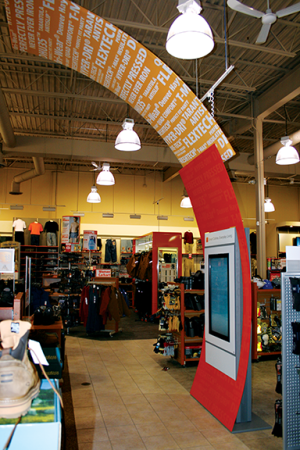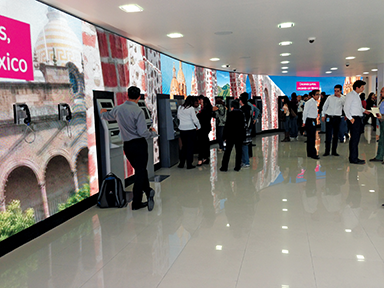
AdFlow Networks in Burlington, Ont., has integrated digital signage systems for high-profile clients like Mark’s Work Wearhouse. Photo courtesy AdFlow Networks
Mature and mainstream
Two high-profile examples of the mainstreaming of digital signage were national movie theatre chain Cineplex Entertainment’s acquisitions of Digital Display & Communications (DDC) in Waterloo, Ont., in 2010 and of EK3 Technologies in London, Ont., in 2013.
DDC and EK3 had separately designed, installed and managed digital signage networks for the retail, financial, hospitality and entertainment industries, including such clients as Tim Hortons, McDonald’s, Walmart, Royal Bank of Canada (RBC) and Bank of Montreal (BMO), earning a positive reputation for high-quality service and customer value.
After the acquisitions, DDC was rebranded under the existing Cineplex Digital Media (CDM) banner, while EK3 was renamed Cineplex Digital Networks (CDN). Today, their integrated efforts (see example on page 121) are enhanced by Cineplex’s broader capabilities, including consumer branding, media production, ad sales, multi-channel marketing and facility management.
“The strengths of CDM and CDN will make us a leader in the indoor digital signage industry and provides a platform for significant growth throughout North America,” said Ellis Jacob, president and CEO of Cineplex, in 2013.
Another change that helped accelerate Canadian digital signage market growth was an asset exchange announced between Sharp’s Audio Visual Canada and AVW-TELAV in late 2011. The latter company’s president, Johanne Bélanger, had been monitoring the maturing of digital signage from a variety of vantage points, including her role as international director of InfoComm International, an IT and audiovisual (AV) industry association.
Today, AVW-TELAV’s Canadian operations are known as Freeman Audio Visual. The company has found digital signage success in the past with clients like Toyota and its expanded capabilities have made it an important new supply force within the Canadian digital signage market.
Christie, an AV system manufacturer that invented MicroTile digital signage ‘cubes’ in Kitchener, Ont., acquired Montreal’s Arsenal Media in 2014, with plans to rename it Christie Creative Media Services. The two companies had worked together on many high-profile projects in the past, including an award-winning video wall for Sun Life Financial.
Collaboration nation
Canadians have a propensity for collaboration where broader benefits can be achieved. For digital signage, this has been well-illustrated through industry gatherings and educational events that have helped build beneficial relationships between suppliers and buyers.

Known for applying a software-as-a-service (SaaS) approach to digital signage, Montreal-based BroadSign International now has more than 200 networks running its software around the world, including this bank in Mexico. Photo courtesy BroadSign International
Indeed, it is fair to suggest digital signage education in North America was ‘founded’ by the Toronto-based Strategy Institute, which began running related conferences in 2004 and helped train thousands of professionals. Its CEO, David Laird, was named ‘Digital Signage Man of the Year’ for 2006 by the Digital Signage Forum.
Today, Dot2Dot, LG Electronics Canada and Vertigo Digital Displays are co-sponsors of the ongoing Digital Media in Canada (DMIC) webinar series. Each session focuses on a different foundation of digital signage success.
The Location Based Marketing Association (LBMA) was founded and continues to be headquartered in Toronto, but has expanded internationally in recent years. Its members include software developers, wireless firms, retailers and ad agencies.
LBMA and many others have taken part in Toronto’s annual Dx3 conferences, which have focused on social, local and mobile (SoLoMo) marketing. Dx3 has grown to the point where it is reportedly Canada’s largest conference and trade show dedicated to digital marketing.
In fall 2014, industry veteran Dave Haynes organized a one-day conference in Toronto called ‘DSrupted,’ focusing on how technological developments are causing major changes for digital signage software, data integration, playback devices and other aspects of the industry. Haynes is already planning a 2015 followup event.
The seventh Digital Trends Showcase (DTS) was held in October 2014, profiling advanced—but already available—approaches to dynamic place-based media branding, merchandising, messaging and engagement through 10 demonstration scenarios, all using the same marketing content from Adidas for the purpose of illustration. Some 500 professionals, representing many of Canada’s best-known brands, attended the event.
Through such hands-on and walk-through demonstrations, Canadian customers are kept up-to-date on rapidly evolving applications for marketing, communications and other new uses for digital signage.
Lyle Bunn is a digital signage analyst, consultant and educator based in Brighton, Ont. For more information, visit www.lylebunn.com.





